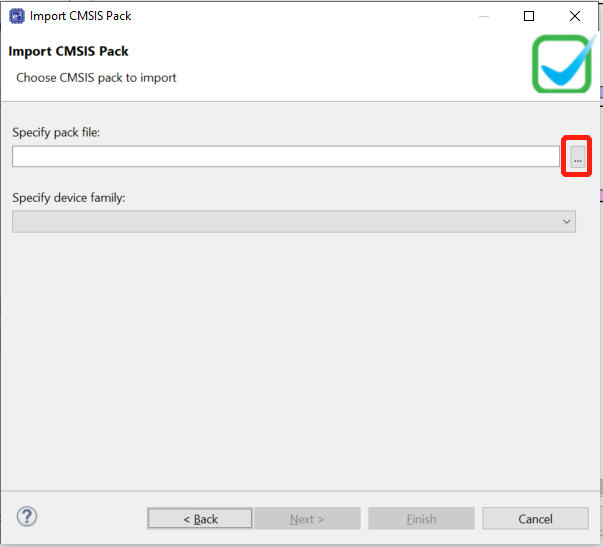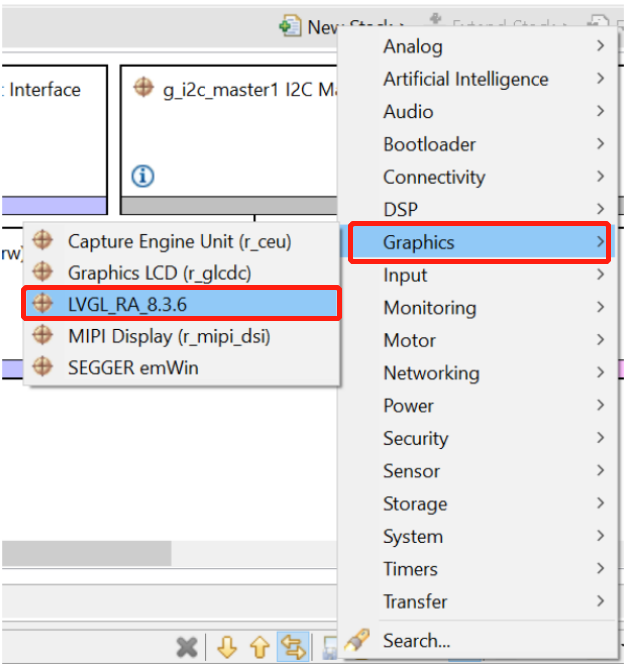

基于RA8D1的LVGL FSP配置以及使用介绍
描述
1
介绍
本文介绍由e2 studio自动生成的FSP LVGL pack的使用说明,Pack的生成方法可以参考前面的介绍文章。用户可以通过添加该pack,以可视化的形式添加和配置Little VGL,包括Little VGL的分辨率、色深、DPI以及官方的demo等进行配置。用户不用再做移植Little VGL的源代码,不用再繁琐的添加各个头文件。本次实验所用硬件为EK-RA8D1,如下图。确保板子的SW1-7切换到“ON”

2
软件架构
通过pack生成的代码主要在ra→fsp→src→rm_lvgl_prot和ra→lvgl两个路径下


3
安装教程
1
打开e2 studio菜单中“File”→“Import... ”

2
在弹出的“Import”对话框中,选择“General”→“CMSIS Pack”,点击“Next”

3
在弹出的“Import CMSIS Pack”对话框中,点击“Specify pack file”右侧“...”,指定需要添加的pack文件

4
“Specify device family”选择“RA”,点击Finish

4
使用说明
1
重新打开e2 studio
2
新建工程,新建工程步骤不再赘述,FSP版本选择5.1.0及以上,Board选择EK-RA8D1
3
新建好工程后,添加LVGL的stack,这时候会提示GLCDC的时钟没有打开,切换到clocks选项卡,enable LCD的clock,选择PLL1P,让LCD时钟输出为240MHz即可。

添加MIPI DSI driver,左键点击Add MIPI DSI Output(Optional)→New→MIPI Display(r_mipi_dsi):

NOTE
Enable LCD的clock后,r_glcdc的红色提示会消失。
修改LVGL显示分辨率:480*854,enable 2D

使能touch

修改glcdc的名字为g_display_lvgl:

4
添加2D驱动,如果上述步骤没有enable 2D,此步骤可以跳过。New Stack→Graphics→D/AVE 2D Port Interface

添加完2D stack后,在BSP选项卡中heap给2D使用,同时加大stack的值为0x2000:

5
添加I2C驱动

修改I2C的配置,Name: g_i2c_master1, Channel: 1, Slave address: 0x5D, Callback: g_i2c_master1_cb, Interrupt Priority Level:Priority 12

6
添加GPIO中断,修改irq的配置:Name:g_external_irq3,Channel:3,Callback:touch_irq_cb

P510设为input模式,IRQ选择为IRQ3

7
配置引脚,改变SDRAM的引脚驱动能力:PA00 -- H, PA08 -- H, PA09 -- HH, PA10 -- H, P404设为输出模式,初始化为高电平,PA01设为输出模式,初始化为高电平
8
点击Generate Project Content,生成代码
9
添加应用代码,做一个LVGL下拉控件。修改 hal_entry.c如下:
左右滑动查看完整代码内容
#include "hal_data.h"
#include "dsi_layer.h"
#include "lvgl.h"
#include "lv_demos.h"
FSP_CPP_HEADER
void R_BSP_WarmStart(bsp_warm_start_event_t event);
FSP_CPP_FOOTER
#define RGB_565_REG (0x1F << 11)
#define RGB_565_GREEN (0x3F << 5)
#define RGB_565_BLUE (0x1F << 0)
/* Global variable to keep track of requested application */
void SysTick_Handler(void);
#define LVGL_TICK_MS 1U
static volatile uint32_t s_tick = 0U;
static volatile bool s_lvglTaskPending = false;
#define LVGL_TASK_PERIOD_TICK 3U
static void DEMO_SetupTick(void)
{
if (0 != SysTick_Config(SystemCoreClock / (LVGL_TICK_MS * 1000U)))
{
while (1)
;
}
}
void SysTick_Handler(void)
{
s_tick++;
lv_tick_inc(LVGL_TICK_MS);
if ((s_tick % LVGL_TASK_PERIOD_TICK) == 0U)
{
s_lvglTaskPending = true;
}
}
#if LV_BUILD_EXAMPLES
static void event_handler(lv_event_t * e)
{
lv_event_code_t code = lv_event_get_code(e);
lv_obj_t * obj = lv_event_get_target(e);
if(code == LV_EVENT_VALUE_CHANGED) {
char buf[32];
lv_dropdown_get_selected_str(obj, buf, sizeof(buf));
LV_LOG_USER("Option: %s", buf);
}
}
void lv_example_dropdown_1(void)
{
/*Create a normal drop down list*/
lv_obj_t * dd = lv_dropdown_create(lv_scr_act());
lv_dropdown_set_options(dd, "Apple
"
"Banana
"
"Orange
"
"Cherry
"
"Grape
"
"Raspberry
"
"Melon
"
"Orange
"
"Lemon
"
"Nuts");
lv_obj_align(dd, LV_ALIGN_TOP_MID, 0, 20);
lv_obj_add_event_cb(dd, event_handler, LV_EVENT_ALL, NULL);
}
#endif
/*******************************************************************************************************************//**
main() is generated by the RA Configuration editor and is used to generate threads if an RTOS is used. This function
is called by main() when no RTOS is used.
**********************************************************************************************************************/
void hal_entry(void)
{
/* TODO: add your own code here */
fsp_err_t err;
/* Fill the Frame buffer with Blue, to zero out info from previous execution runs */
uint32_t count;
uint16_t * p = (uint16_t *)&fb_background[0][0];
for (count = 0; count < sizeof(fb_background)/2; count++)
{
*p++ = RGB_565_REG;
}
DEMO_SetupTick();
lv_init();
lv_port_disp_init();
#if Touch_Enable
lv_port_indev_init();
#endif
lv_example_dropdown_1();
#if LV_USE_DEMO_WIDGETS
// lv_demo_widgets();
#endif
#if LV_USE_DEMO_STRESS
lv_demo_stress();
#endif
#if LV_USE_DEMO_BENCHMARK
lv_demo_benchmark();
#endif
#if LV_USE_DEMO_MUSIC
lv_demo_music();
#endif
// lv_task_handler();
/* handle the tasks of LVGL */
while(1)
{
while (!s_lvglTaskPending)
{
}
s_lvglTaskPending = false;
lv_task_handler();
}
#if BSP_TZ_SECURE_BUILD
/* Enter non-secure code */
R_BSP_NonSecureEnter();
#endif
}
/*******************************************************************************************************************//**
This function is called at various points during the startup process. This implementation uses the event that is
called right before main() to set up the pins.
*
* @param[in] event Where at in the start up process the code is currently at
**********************************************************************************************************************/
void R_BSP_WarmStart(bsp_warm_start_event_t event)
{
if (BSP_WARM_START_RESET == event)
{
#if BSP_FEATURE_FLASH_LP_VERSION != 0
/* Enable reading from data flash. */
R_FACI_LP→DFLCTL = 1U;
/* Would normally have to wait tDSTOP(6us) for data flash recovery. Placing the enable here, before clock and
C runtime initialization, should negate the need for a delay since the initialization will typically take more than 6us. */
#endif
}
if (BSP_WARM_START_POST_C == event)
{
/* C runtime environment and system clocks are setup. */
/* Configure pins. */
R_IOPORT_Open (&g_ioport_ctrl, &IOPORT_CFG_NAME);
bsp_sdram_init(); //SDRAM pins need to be set to HIGH drive strength in pin configuration
}
}
#if BSP_TZ_SECURE_BUILD
FSP_CPP_HEADER
BSP_CMSE_NONSECURE_ENTRY void template_nonsecure_callable ();
/* Trustzone Secure Projects require at least one nonsecure callable function in order to build (Remove this if it is not required to build). */
BSP_CMSE_NONSECURE_ENTRY void template_nonsecure_callable ()
{
}
FSP_CPP_FOOTER
#endif
10
编译,下载到EK-RA8D1,连接MIPI屏,会得到以下结果:

至此,已经完成LVGL的移植以及测试。下面我们直接配置FSP,把官方的demo使能起来:打开configuration.xml,配置如下:

配置完成后,点击Generate Project Content。修改hal_entry.c:
#include "hal_data.h"
#include "dsi_layer.h"
#include "lvgl.h"
#include "lv_demos.h"
FSP_CPP_HEADER
void R_BSP_WarmStart(bsp_warm_start_event_t event);
FSP_CPP_FOOTER
#define RGB_565_REG (0x1F << 11)
#define RGB_565_GREEN (0x3F << 5)
#define RGB_565_BLUE (0x1F << 0)
/* Global variable to keep track of requested application */
void SysTick_Handler(void);
#define LVGL_TICK_MS 1U
static volatile uint32_t s_tick = 0U;
static volatile bool s_lvglTaskPending = false;
#define LVGL_TASK_PERIOD_TICK 3U
static void DEMO_SetupTick(void)
{
if (0 != SysTick_Config(SystemCoreClock / (LVGL_TICK_MS * 1000U)))
{
while (1)
;
}
}
void SysTick_Handler(void)
{
s_tick++;
lv_tick_inc(LVGL_TICK_MS);
if ((s_tick % LVGL_TASK_PERIOD_TICK) == 0U)
{
s_lvglTaskPending = true;
}
}
#if LV_BUILD_EXAMPLES
static void event_handler(lv_event_t * e)
{
lv_event_code_t code = lv_event_get_code(e);
lv_obj_t * obj = lv_event_get_target(e);
if(code == LV_EVENT_VALUE_CHANGED) {
char buf[32];
lv_dropdown_get_selected_str(obj, buf, sizeof(buf));
LV_LOG_USER("Option: %s", buf);
}
}
void lv_example_dropdown_1(void)
{
/*Create a normal drop down list*/
lv_obj_t * dd = lv_dropdown_create(lv_scr_act());
lv_dropdown_set_options(dd, "Apple
"
"Banana
"
"Orange
"
"Cherry
"
"Grape
"
"Raspberry
"
"Melon
"
"Orange
"
"Lemon
"
"Nuts");
lv_obj_align(dd, LV_ALIGN_TOP_MID, 0, 20);
lv_obj_add_event_cb(dd, event_handler, LV_EVENT_ALL, NULL);
}
#endif
/*******************************************************************************************************************//**
* main() is generated by the RA Configuration editor and is used to generate threads if an RTOS is used. This function
* is called by main() when no RTOS is used.
**********************************************************************************************************************/
void hal_entry(void)
{
/* TODO: add your own code here */
fsp_err_t err;
/* Fill the Frame buffer with Blue, to zero out info from previous execution runs */
uint32_t count;
uint16_t * p = (uint16_t *)&fb_background[0][0];
for (count = 0; count < sizeof(fb_background)/2; count++)
{
*p++ = RGB_565_REG;
}
DEMO_SetupTick(); //为lvgl提供心跳
lv_init();
lv_port_disp_init();
#if Touch_Enable
lv_port_indev_init();
#endif
// lv_example_dropdown_1();
#if LV_USE_DEMO_WIDGETS
lv_demo_widgets();
#endif
#if LV_USE_DEMO_STRESS
lv_demo_stress();
#endif
#if LV_USE_DEMO_BENCHMARK
lv_demo_benchmark();
#endif
#if LV_USE_DEMO_MUSIC
lv_demo_music();
#endif
// lv_task_handler();
/* handle the tasks of LVGL */
while(1)
{
while (!s_lvglTaskPending)
{
}
s_lvglTaskPending = false;
lv_task_handler();
}
#if BSP_TZ_SECURE_BUILD
/* Enter non-secure code */
R_BSP_NonSecureEnter();
#endif
}
/*******************************************************************************************************************//**
* This function is called at various points during the startup process. This implementation uses the event that is
* called right before main() to set up the pins.
*
* @param[in] event Where at in the start up process the code is currently at
**********************************************************************************************************************/
void R_BSP_WarmStart(bsp_warm_start_event_t event)
{
if (BSP_WARM_START_RESET == event)
{
#if BSP_FEATURE_FLASH_LP_VERSION != 0
/* Enable reading from data flash. */
R_FACI_LP→DFLCTL = 1U;
/* Would normally have to wait tDSTOP(6us) for data flash recovery. Placing the enable here, before clock and
* C runtime initialization, should negate the need for a delay since the initialization will typically take more than 6us. */
#endif
}
if (BSP_WARM_START_POST_C == event)
{
/* C runtime environment and system clocks are setup. */
/* Configure pins. */
R_IOPORT_Open (&g_ioport_ctrl, &IOPORT_CFG_NAME);
bsp_sdram_init(); //SDRAM pins need to be set to HIGH drive strength in pin configuration
}
}
#if BSP_TZ_SECURE_BUILD
FSP_CPP_HEADER
BSP_CMSE_NONSECURE_ENTRY void template_nonsecure_callable ();
/* Trustzone Secure Projects require at least one nonsecure callable function in order to build (Remove this if it is not required to build). */
BSP_CMSE_NONSECURE_ENTRY void template_nonsecure_callable ()
{
}
FSP_CPP_FOOTER
#endif
编译,下载。得到结果如下:

如果实验过程有问题,可以下载本仓库中e2studio_project下的RA8D1_simple_demo和RA8D1_widgets_demo两个完整的工程做对比。
基于RA8D1的LVGL FSP配置以及使用已经介绍完毕。
审核编辑:刘清
-
【Vision Board创客营连载体验】RA8D1 Vision Board Camera 初体验2024-04-27 1546
-
【瑞萨RA8D1 CPK开发板】RA8D1移植ThreadX操作系统2024-10-20 2441
-
【CPKCOR-RA8D1】RA8D1开箱测试报告2025-10-02 6652
-
【CPKCOR-RA8D1】2、运行LVGL2025-10-10 2005
-
【CPKCOR-RA8D1】基于G.729A算法研究2025-10-31 1914
-
瑞萨电子宣布推出RA8D1微控制器(MCU)产品群2023-12-15 1936
-
使用FSP配置RA的CAN模块(下)2023-08-05 1274
-
RA8D1微控制器组评估套件快速入门指南2024-01-31 339
-
瑞萨RA8D1 CEU介绍与使用说明2024-02-20 4383
-
基于瑞萨电子RA系列的野火耀阳RA8D1开发板产品简介2024-05-29 2147
-
基于Arm Cortex-CM85内核的RA8D1作为控制器 通过MIPI DSI实现LVGL显示2024-06-07 3284
-
【RA8D1试用活动】RA8D1B-CPKCOR开发板移植linux2024-11-16 1500
-
RA8D1加密引擎功能体验和实践2024-11-23 1505
-
瑞萨RA8D1单片机IO中断配置实现方法2025-04-09 1611
-
基于瑞萨电子RA8D1 MCU的USB和I2S数字音频应用解决方案2025-04-30 2560
全部0条评论

快来发表一下你的评论吧 !

